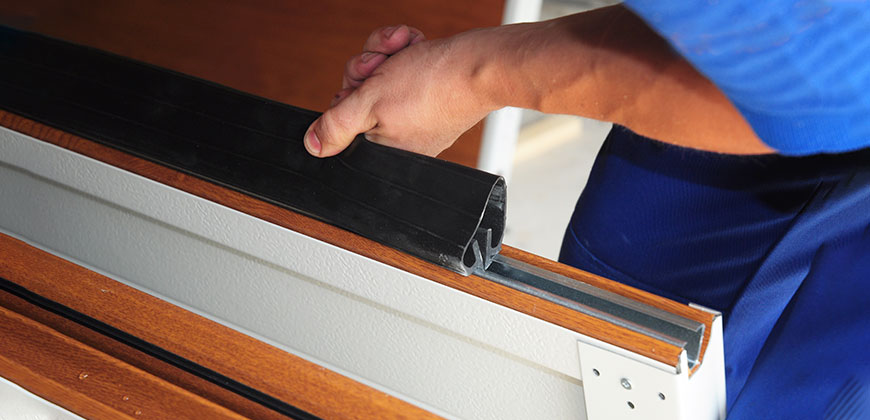
5 Garage Door Sealing Tips to Keep Out Drafts, Dust, and Pests
A garage door with gaps is an open invitation to cold air, dust, and critters. We at TBC Garage Doors have seen how even small leaks can make a garage uncomfortable and energy-inefficient. Whether you’re a homeowner, property manager or business owner, our five tips on garage door sealing and weatherstripping will help you block drafts and keep your garage clean, dry and pest-free.
Tip 1: Ensure a Solid Garage Door Bottom Seal
The door bottom seal (or door sweep) is your first line of defence. This flexible strip – usually made of rubber, vinyl or a sturdy brush – attaches along the bottom edge of the door. When the door closes, it compresses against the floor or threshold to stop drafts, water, and pests. We recommend checking this seal every year. If you see light under the closed door, feel a breeze, or notice water entering during rain or snow melt, replace the seal. In Canadian winters, seals can crack or stiffen, so we use heavy-duty materials (like Santoprene rubber or silicone) rated for very low temperatures.
- Rubber/Vinyl sweeps: Many garage doors use a U-shaped rubber or vinyl seal fitted into an aluminium channel (often called a T-astragal). We carry a range of profiles (single or double bulb, V-shaped ends, etc.) to match the gap height. These seals either slide into a retainer channel or nail on directly. We pick pliable, UV-resistant rubber that stays soft in -30°C and compresses tightly against the floor.
- Thresholds: A floor-threshold seal is an adhesive vinyl strip that sticks to the concrete just inside the door. It creates a raised dam that blocks water and dust. Thresholds are great if your driveway slopes toward the garage, but remember to clear debris and ice from them – a clogged threshold can trap water or snow. We install frost-break versions (with plastic separators) to prevent them from freezing solid in winter.
- Brush (pile) seals: For large commercial doors or warped slabs, a metal box with nylon bristles can fill extra-wide gaps. These brush sweeps are durable and handle constant use, though they seal somewhat less tightly than rubber. We use them in industrial settings or on very uneven floors where a rubber sweep wouldn’t sit flush.
A properly chosen door bottom seal stops the biggest gaps. At our clients’ homes and businesses, upgrading the bottom seal is often the most effective fix – almost instantly you feel fewer cold drafts.
Tip 2: Weatherstripping for the Door’s Sides and Top
Sealing only the bottom still leaves the sides and top vulnerable. To fully weatherstrip the garage door, install compressible strips along the vertical door jambs and the header (top frame). Typically, we attach weatherstripping to the wood or vinyl door-stop molding so that when the door closes, the strip’s flexible flange presses against the door edge.
- Doorstop strips: The most common method is a PVC or rubber flap nailed to the L-shaped stop trim on each side and across the top. We drive corrosion-resistant nails or screws through the flange so it presses firmly into the door’s face. When installing, we trim the strips at a slight angle or overlap joints at the corners to avoid holes at the seams. The result is a continuous seal around the door perimeter.
- V-strip (tension) seals: Also called T-strip or tension seal, this is a springy V-shaped vinyl or metal strip. We cut it to length and insert it at the top and sides of the door panels. When the door closes, each V strip is pinched into a flat seal. These are excellent for sealing the joints of older panel doors that have flat edges (new doors often have interlocking edges that do this job already).
- Integrated weatherstrip molding: When a door’s wooden stop molding is rotten or damaged, we sometimes install a one-piece PVC stop with weatherstrip built in. This specialty jamb stop looks like wood molding on the outside but has a built-in vinyl strip along the back. We cut it to length, nail it up, and the weatherstrip gets squeezed against the door. It’s a neat solution that seals without visible cracks.
- Foam or felt tape (starter option): In a pinch, adhesive foam tape or reinforced felt can be stuck onto the stop. While we prefer heavier-duty materials, foam tape is easy for a quick fix and works on less-used doors. Just know that foam or felt will compress and wear out faster, especially in wet or windy conditions.
With new weatherstripping on the sides and top, the garage door frame becomes almost airtight. We often find this step reduces room for noisy bugs and cold air to sneak in. Proper installation – correct overlap at corners and just enough compression – is key to garage door sealing.
Tip 3: Insulate Your Garage After Garage Door Sealing
Sealing air leaks is one part; insulation is the other. An insulated garage is more comfortable and energy-efficient, especially for attached garages or those used as workshops. Many newer garage doors come with insulated panels (often foam cores) rated by R-value. For an older or single-layer door, we add insulation ourselves.
- Panel insulation kits: These kits include rigid foam boards (polystyrene or polyurethane) cut for each door panel or fiberglass batts with retainer clips. A common choice is closed-cell polystyrene panels (about R-8 per inch). For example, 2-inch thick foam has roughly R-16, which is excellent for a garage door. We attach these panels inside each section, using the door’s grooved edges to hold them, plus clips or tape as needed.
- Spray foam insulation: For maximum R-value and a perfect fill of gaps, spray-in-place polyurethane is an option. This must be done carefully (usually by pros) because it expands to fill cracks. The result is a high R-value (~R-6 per inch) and adds rigidity to the door. We might recommend spray foam for garages that double as living or working space, where comfort matters year-round.
- Attic and wall insulation: Don’t forget the rest of the garage. Even the best door insulation can be undermined if the walls or ceiling are uninsulated. We suggest insulating walls and the ceiling or attic hatch to at least the same standard as the door. In Canada, a good rule of thumb is aiming for at least R-12 for an attached garage (more if there’s a room above). In fact, experts recommend R-14–16 if there’s living space on top. So if you’re doing one part, consider insulating the whole garage – it makes the door’s sealing work even better.
- Reflective barriers: Some homeowners ask about radiant barriers. A foil-faced insulation or bubble insulation adds a bit of R-value (reflecting heat back inside in winter). We sometimes layer a reflective foil board or bubble wrap behind the foam panels for extra bang. It’s an easy add-on if you want to maximize efficiency.
Adding insulation helps stabilize temperatures. Your furnace won’t have to work so hard when you open the door, and your cooled air stays in during summer. After insulating, we always recheck the seals. Sometimes adding thickness to panels means the door doesn’t fully compress old weatherstrips – we then trim or replace the strips so everything fits snug again.
Tip 4: Weatherstripping Maintenance and Seal Upgrades
Even the best seals need attention over time. We advise checking your door bottom seal and weatherstripping at least once a year – ideally in spring and fall. Regular maintenance is one of the best ways to avoid cold drafts and critter entry.
- Inspect for leaks: Close the garage door and look along the bottom, sides, and top. If you see daylight or feel air, identify the spot. Often a spring thaw or rain reveals where a seal has pulled loose or worn thin.
- Clean sealing surfaces: Dirt and debris can prevent a good seal. After heavy dust or leaf fall, wipe off rubber sweeps and doorstops. A soft brush or damp cloth will keep weatherstrips clean. Also clear debris from the threshold so the bottom seal can meet the floor evenly.
- Tighten fasteners: Over time nails or screws that hold the weatherstrip can back out. Tap any loose nails back or replace them. For doorbottom retainer channels, check that they’re still firmly anchored.
- Replace worn parts: Rubber and vinyl degrade with UV, road salt and cold. As a guideline, plan to replace rubber sweeps every 3–5 years in harsh climates. Foam or vinyl weatherstrips may need swapping even sooner. We often set reminders for clients or put these checks on the seasonal maintenance list.
- Professional tune-ups: If you have many garages (a rental property, condo, or business fleet), consider a service contract. We offer inspection packages to systematically replace failing seals and adjust doors. This proactive approach catches problems like rodent damage or cracked thresholds before tenants or customers notice.
Sticking to a maintenance schedule makes all our work last longer. We’ve helped property managers save money by preventing one leaky door from affecting several units. A little upkeep means big savings on heating and fewer pest problems in the long run.
Tip 5: Garage Door Sealing for Commercial and Multi-Unit Garages
In commercial settings or multi-unit complexes, garage doors often see extra abuse and bigger gaps. The principles of garage door sealing are the same, but the materials are beefier.
- Heavy-duty seals: For example, a warehouse roll-up may use a steel track with a rubber astragal at the bottom, plus a brush or bulb seal on top. We provide reinforced neoprene or vinyl strips with multiple sealing lips. These can endure hundreds of cycles per day. Even large overhead doors on truck bays get larger sweeps and multiple side gaskets to stay tight.
- Coordinated upgrades: If you manage an apartment complex or commercial plaza, uniformity is key. We can help you standardize on one seal type or weatherstrip profile so you buy in bulk. Then we schedule installations so all the doors on-site get updated at once, avoiding the patchwork of different aged seals.
- Special requirements: Some businesses have unique needs. A cold-storage garage might need ultra-insulating seals; a shop selling electronics might want seals that also cut noise. For properties near farmland or woods, we choose seals that deter rodents and insects (for instance, all-metal retainer strips that a mouse can’t chew through). We also ensure any fire- or smoke-rated doors keep their ratings when weatherstripped properly.
- Ongoing service: We offer regular inspections for commercial clients and property managers. This can be part of a building maintenance plan. That way, a tenant in Unit 7 never has a chilled garage due to a damaged seal—we catch it on a checklist visit.
Whether it’s a single home garage or a set of industrial bays, sealing the gaps makes each garage operate more efficiently. In business or property management, the energy savings and reduced complaints quickly justify the investment.
Garage Door Sealing: Professional Help and Next Steps
A well-sealed garage door is a small change with big rewards: lower energy costs, fewer pests, and a more comfortable space. By installing a high-quality door bottom seal, adding weatherstripping on the sides and top, insulating the door, and keeping up with maintenance, we make sure drafts and dirt stay outside.
We at TBC Garage Doors serve homeowners and businesses across Canada, using products rated for our tough weather. If you’re ready to seal off the elements, visit our garage door sealing services page or call us for a free consultation. Our team can recommend the right weatherstripping, door sweeps, or insulation for your needs and get the job done quickly. Let us help you enjoy a warmer, cleaner, and more secure garage all year long!
Reach out to TBC Garage Doors today at 647-929-8224 or click here to get in touch online.





















